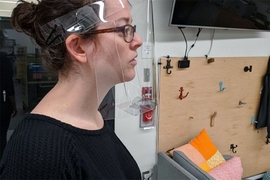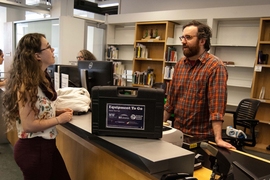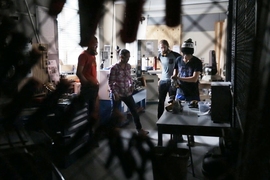Making is central to MIT’s identity. It is the embodiment of MIT’s motto, "mens et manus" — "mind and hand." For many students, making is more than designing, engineering, arts, and crafts; it is an act of community. But as campus closed in response to the Covid-19 pandemic in March, makerspaces were shuttered across campus and many students had to abandon their projects.
With most of these spaces remaining closed to students over the summer, a remote making resource site for students was recently launched to enable safe making from home. Developed by MIT Project Manus and MIT Environment, Health, and Safety (EHS), the site functions as a wiki guiding students and their faculty supervisors’ decisions about how to make remotely while still putting safety first.
“We created this framework for decision-making about what is and what is not okay to do off campus in terms of making things for MIT-sponsored purposes,” says Martin Culpepper, professor of mechanical engineering and director of Project Manus.
The idea for the framework stemmed from a number of conversations Culpepper and Tolga Durak, managing director of EHS Programs at MIT, had with faculty and students shortly after campus closed in March. Many were unsure what, if any, kinds of making activities were safe for students to do remotely. Out of an abundance of caution, some faculty didn’t feel comfortable asking students to do even simple, elementary-level making remotely.
“We want to say 'yes' as much as possible to students asking to make things at home. But making doesn’t matter at MIT if it isn’t done safely,” Culpepper adds.
Culpepper teamed up with Durak to create a set of guidelines that provided a clear path to students and faculty interested in making remotely this summer. Together, their teams developed a wiki that details how to approach remote making by different activity types such as chemistry, woodworking, and 3D printing.
“We are trying to find ways to enable activities that are in MIT’s core DNA to take place even during these difficult times," says Durak.
Color coding by risk
The wiki is informed by a color-coded key that clearly indicates what steps to take depending on the tools and materials a student will be using for their MIT-sponsored projects.
Green tools include a set of low-risk tools that don’t require tool specific training. Things like scissors, latex house paint, and sewing machines fall under the green category. Students aren’t required to ask for permission to use these items for MIT-sponsored making.
“Green light items are low-risk enough that even grade school aged kids can use them,” explains Culpepper. “The framework gives students and faculty members peace of mind that they don’t have to ask and can proceed with using these tools.”
The next tier of tools, yellow, are also considered low-risk but may require additional training, preparation, or PPE. These include many items found a local hardware stores such as hand drills or Dremel tools. Students who need to use these items to complete their work for MIT must sign a risk acknowledgement form and fill out a safety checklist. The Project Manus and EHS teams will then review the checklist and give written permission for students to use them.
Tools that pose moderate risk are classified as orange. Items such as table saws, wood lathes, propane torches, and many chemicals are included under this category.
“Orange tools fall in the middle. Many students have probably used them at home before, but when using them for MIT purposes we really want to make sure they understand all the hazards and make a plan to use them safely,” Culpepper says.
As with yellow tools, students are required to sign a risk acknowledgement form to use orange tools. They are also required to develop a safety plan which they will then discuss with a member of the Project Manus and EHS teams.
Tools in the red category are considered high risk tools and technologies that would typically only be used under supervision on campus. Nuclear materials, composites and resins, and industrial adhesives are some of the items that fall under this category. Permission to work with any of these tools or materials at the request of MIT faculty would be exceedingly rare and only permitted under extraordinary circumstances.
Culpepper acknowledges that some students will have access to tools at home, while others may not. Ensuring equity in tool access is an important component of remote making. In cases where a tool or material is required for an MIT sponsored project, the research lead or faculty member would be responsible for providing their students with tools. If a tool or material can’t be shipped to a student’s address, the Project Manus and EHS team will work with them on identifying open makerspaces nearby that might be able to help.
The framework will be piloted over the summer. In particular, the Project Manus and EHS teams hope faculty and students participating in the summer Undergraduate Research Opportunities Program (UROP) will be able to utilize it.
“This framework will help us rejuvenate the UROP program in a different mode than we are used to,” adds Durak. “We aren’t going to stay stagnant just because everyone is remote. We want to focus on doing things safely instead of being in a state of paralysis.”
Connecting the making community
Each maker space and making program at MIT has its own culture and community. Since shifting to remote education this spring, these communities have had to be agile and develop new ways to foster that sense of community. Angelina Jay, technical instructor at Project Manus and director of the MakerLodge Program, turned to Zoom to keep the making community connected.
“We’ve been hosting a crafting corner each week for students, faculty, and staff to hang out on Zoom,” Jay explains. “It’s a great way to carve out some time each week for making – whether it’s coloring for an hour, making origami, or building a robot.”
While this crafting corner and other similar remote meet-ups like it focus on personal projects that aren’t part of an official MIT research or learning, Jay expects the framework could help guide students’ personal making projects as well.
Whether it’s for informal crafting corners or UROP research projects, the framework can help re-establish the sense of community that was lost for many in the transition to remote work.
“There is a significant concern that people are feeling isolated right now,” says Durak. “The hope is that this framework will help us feel like a community again while also keeping people safe.”
Looking to the future
Culpepper and Durak expect to iterate and improve the framework and related resources throughout the pilot phase this summer. Regardless of which scenario is chosen for fall semester, the framework will likely be a tool faculty can utilize in their courses.
“Even in the best-case scenario for fall, there will still be value in facilitating remote making for students who, for whatever reason, are unable to be on campus,” adds Durak. “In the worst-case scenario, then the framework makes us far better prepared.”
The Project Manus and EHS teams will be running a class this summer to train faculty, EHS and safety professionals, and technical staff on how to facilitate remote making safely.
Using the information learned over the summer, the team will also share their experiences with peers at other institutions.
“MIT is in a position to lead the charge. Even when things go back to normal, we can use what we learn through this framework and find a “second gear” for what is possible with both on site and remote making at MIT,” says Durak.











